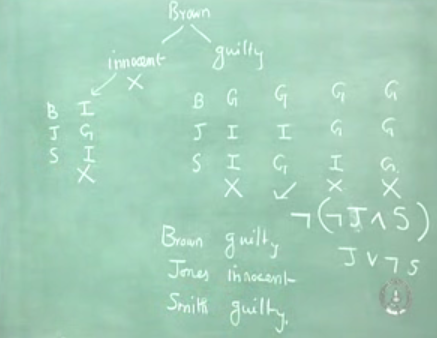Formalize the following arguments as syntactic sequents of the propositional calculus,
giving an explicit interpretation of your sentence-letters.
The murderer was either Colonel Mustard or Professor Plum. But it wasn’t
Professor Plum. So it was Colonel Mustard.
P = The murderer was Colonel Mustard
Q = The murderer was Professor Plum
(P x Q) ^ not Q => P

We can see from the table that (P x Q) ^ not Q => P is a logical implication (tautology) and that we can conclude that P must be true if P x Q ^ not P is true. Therefore it is proved that The murderer was Colonel Mustard.
Either the Master or the Dean was in the library. But if the Master wasn’t there,
the Dean wasn’t there either. So they were both in the library.
P = the Master was in the library.
Q = the Dean was in the library.
not (P x Q) => (P ^ Q)

We can see from the table that not (p x q) does imply (p ^ q) and that p and q are true, thus it is proven that the Master was in the library and the Dean was in the library.
You can only buy a Young Persons railcard if you’re under 26 or a student;
otherwise not. If you can buy a Young Persons railcard, you can get discounted
train tickets. But you’re not under 26. So unless you’re a student, you can’t get
discounted train tickets
P = You are under 26
Q = You are a student
R = You can buy a Young person rail card
S = You can get a discount
not (((P v Q) => R) => S) => not S v Q
(I cannot be bothered to do a truth table for this – so cannot prove that my answer is correct – but I am pretty sure that is – so mybe you would like to do one and let me know?)
If God is willing to prevent suffering, but unable to do so, He is not omnipotent. If
He is able to prevent suffering, but unwilling to do so, He is not loving. If God
exists, He is loving and omnipotent. And if He is both willing and able to prevent
suffering, then there can’t be any suffering – but there is. So God doesn’t exist.
P = God is willing to prevent suffering
Q = God is omnipotent
R = God is able to prevent suffering
S = God is loving
T = God exists
U = There is no suffering
not (((P ^ not R) => not Q) ^ ((P ^ not P) => not S) ^ ((P ^ R) => not U)) => not T
(I cannot be bothered to do a truth table for this – so cannot prove that my answer is correct – but I am pretty sure that is – so maybe you would like to do one and let me know?)
The protesters will go away if Oxford stops experiments on animals. But this
could only happen with government intervention. So, unless the government
intervenes, they won’t go away
P = The protesters will go away
Q = Oxford stops experiments on animals
R = the government intervenes
not ((Q => P) => R) => not P

Here we can see that not ((Q => P) => R) => not P , not P and not ((Q => P) => R) are all true, thus we can conclude that not ((Q => P) => R) => not P is true.



 Q) as a proposition S, (Q
Q) as a proposition S, (Q 






